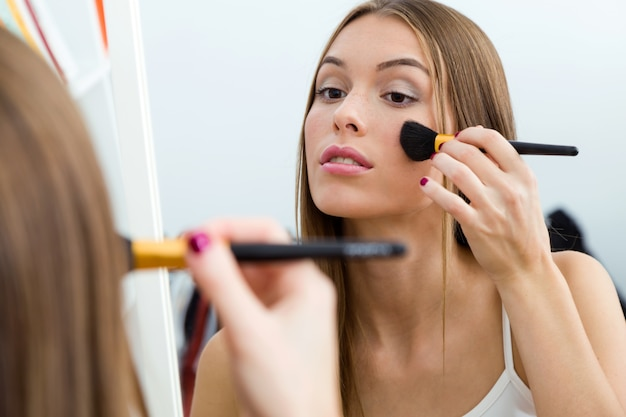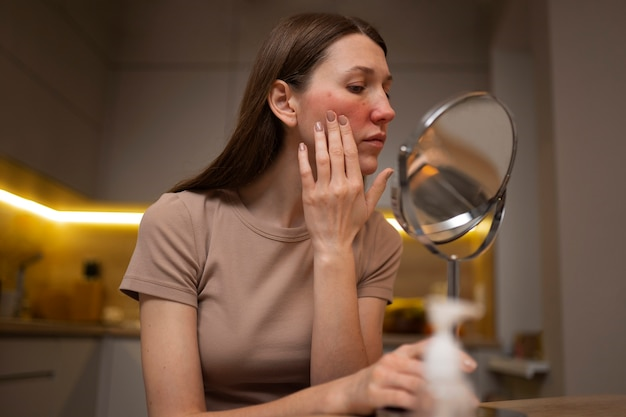All About Exfoliation: Benefits, Types, and How Often to Exfoliate
All About Exfoliation: Exfoliation is a fundamental aspect of skincare that has gained immense popularity for its ability to rejuvenate and revitalize the skin. This essential practice involves the removal of dead skin cells, revealing a fresh, radiant complexion underneath. Whether you’re aiming for a glowing, youthful appearance or seeking solutions for specific skin concerns, understanding the benefits, different types of exfoliation, and the recommended frequency of this skincare ritual can help you achieve your desired results. In this comprehensive guide, we will delve into the world of exfoliation, exploring its advantages, various methods, and how to determine the right exfoliation routine for your unique skin type.

Exfoliation
Exfoliation is the process of sloughing off dead skin cells that accumulate on the outer layer of the skin. This buildup can lead to a dull complexion, clogged pores, and other skin issues. By removing these dead cells, exfoliation stimulates cell turnover and helps reveal fresher, younger-looking skin underneath.
Types of Exfoliation
There are two main types of exfoliation: physical exfoliation and chemical exfoliation.
Physical Exfoliation
Physical exfoliation involves the use of abrasive particles or tools to manually scrub away dead skin cells. Common physical exfoliants include facial scrubs, brushes, and loofahs. While this method can be effective, it is crucial to use gentle exfoliants to avoid damaging the skin.
Chemical Exfoliation
Chemical exfoliation, on the other hand, utilizes chemical compounds, such as alpha hydroxy acids (AHAs) or beta hydroxy acids (BHAs), to dissolve the bonds between dead skin cells. This process allows the dead skin cells to be shed naturally, revealing fresh, glowing skin. Chemical exfoliation is generally considered to be more effective and less likely to cause physical irritation when compared to physical exfoliation.
Exfoliating Products
There is a wide array of exfoliating products available in the market today, catering to various skin types and concerns. Here are some popular exfoliating products:
Exfoliating Scrubs
These products typically contain fine granules or microbeads that gently exfoliate the skin when massaged in a circular motion. Look for scrubs with natural exfoliants like apricot seeds or jojoba beads to minimize environmental impact.
Chemical Exfoliants
Chemical exfoliants come in the form of toners, serums, and masks containing AHAs (e.g., glycolic acid) or BHAs (e.g., salicylic acid). AHAs are suitable for dry or sensitive skin, while BHAs are excellent for oily and acne-prone skin.
Enzyme Exfoliants
These exfoliants use enzymes derived from fruits (e.g., papaya or pineapple) to gently break down dead skin cells. Enzyme exfoliants are generally well-tolerated by most skin types.
Exfoliating Brushes and Tools
There are electronic facial brushes and exfoliating gloves designed to aid in physical exfoliation. Be cautious with these tools, as they can be harsh on the skin if not used properly.
Exfoliation Methods
Exfoliation can be incorporated into your skincare routine in several ways:
Manual Exfoliation
For manual exfoliation, apply a small amount of exfoliating scrub to damp skin and gently massage in circular motions, focusing on areas prone to dryness or congestion. Rinse thoroughly with warm water and pat the skin dry.
Chemical Exfoliation
When using chemical exfoliants, follow the product instructions carefully. Typically, you would apply a small amount to cleansed skin and allow it to sit for a specified time before rinsing or proceeding with the rest of your skincare routine.
Enzyme Exfoliation
To use enzyme exfoliants, apply the product to clean skin and leave it on for the recommended time before rinsing off. Enzyme exfoliants are often gentle enough to use a few times a week.
Exfoliation Benefits
Exfoliation offers numerous benefits for the skin:
-
- Exfoliation helps to smoothen the skin’s surface, reducing the appearance of roughness and enhancing overall texture.
-
- By removing dead skin cells, exfoliation reveals fresher, more radiant skin, giving you that coveted healthy glow.
-
- Regular exfoliation can prevent the buildup of debris and oils in the pores, reducing the likelihood of blackheads and breakouts.
-
- Exfoliating clears the path for other skincare products to penetrate deeper into the skin, making them more effective.
-
- Stimulating cell turnover through exfoliation can lead to the reduction of fine lines and wrinkles over time.
-
- Exfoliating can help fade dark spots and hyperpigmentation, leading to a more even skin tone.
How Often to Exfoliate
The frequency of exfoliation depends on your skin type and the exfoliation method used. As a general guideline:
Normal/Combination Skin
If you have normal or combination skin, exfoliating two to three times a week should suffice to maintain a healthy complexion.
Dry/Sensitive Skin
For those with dry or sensitive skin, it’s best to exfoliate only once a week to avoid over-stripping the skin of its natural oils.
Oily/Acne-Prone Skin
Oily and acne-prone skin can benefit from more frequent exfoliation, around three to four times a week, to help control excess oil and prevent breakouts.
Facial Exfoliation
Facial exfoliation is a crucial aspect of skincare as it helps remove dead skin cells, excess oils, and impurities from the skin’s surface. By sloughing off these dull and damaged cells, facial exfoliation promotes cell turnover, allowing fresher skin to emerge, resulting in a more radiant and youthful appearance.
The Benefits of Regular Exfoliation
Regular exfoliation, whether for the face or body, offers a host of benefits:
-
- Exfoliation helps to smoothen the skin’s surface, reducing roughness and leaving the skin feeling soft and silky.
-
- By removing dead skin cells, exfoliation can help even out skin tone, reducing the appearance of dark spots and hyperpigmentation.
-
- Exfoliating clears away debris and allows skincare products to penetrate more effectively, maximizing their benefits.
-
- Exfoliation can help unclog pores and reduce their appearance, leading to a clearer complexion.
-
- Regular exfoliation can prevent the buildup of bacteria and sebum, reducing the occurrence of acne and breakouts.
-
- Stimulating cell turnover through exfoliation can aid in reducing the appearance of fine lines and wrinkles.
Body Exfoliation
While facial exfoliation is well-known, body exfoliation is equally important. The skin on our bodies can also benefit from regular exfoliation to maintain its health and radiance. Body exfoliation can be accomplished using similar methods as facial exfoliation, such as physical and chemical exfoliants.
Physical Body Exfoliants
Body scrubs containing exfoliating particles like sugar or salt are popular for body exfoliation. When using these scrubs, apply them in circular motions during a shower or bath to reveal smoother skin.
Chemical Body Exfoliants
Chemical exfoliants designed for the body, such as body lotions or serums with AHAs or BHAs, can be applied after showering to promote gentle exfoliation.
Natural Exfoliation Methods
For those who prefer a more natural approach, several natural exfoliation methods can be easily incorporated into a skincare routine:
Oatmeal Scrub
A gentle oatmeal scrub can be made by mixing ground oatmeal with water or yogurt to create a paste. Massage this mixture onto damp skin for a soothing exfoliation experience.
Honey and Brown Sugar Scrub
Mix honey and brown sugar to create a hydrating and nourishing body scrub that helps remove dead skin cells and moisturizes the skin.
Coffee Grounds Exfoliation
Used coffee grounds can be combined with coconut oil to create an invigorating body scrub that also helps reduce the appearance of cellulite.
How to Exfoliate Sensitive Skin
Exfoliating sensitive skin requires special care to avoid irritation and redness. Here are some tips for exfoliating sensitive skin effectively:
Choose Mild Exfoliants
Opt for gentle exfoliants with smaller particles, such as oatmeal or rice powder, to minimize the risk of irritation.
Patch Test
Before applying any exfoliant to sensitive areas, perform a patch test on a small area of skin to check for adverse reactions.
Limit Frequency
Sensitive skin should be exfoliated less frequently, about once a week or as tolerated.
Be Gentle
When exfoliating sensitive skin, use light pressure and avoid harsh rubbing to prevent irritation.
Manual Exfoliation
Manual exfoliation refers to the use of physical techniques, such as brushes, loofahs, or washcloths, to manually remove dead skin cells. This method is particularly effective for the body, where the skin is thicker and more resilient than the delicate facial skin. When employing manual exfoliation, remember to use gentle pressure and circular motions to avoid damaging the skin.
Exfoliation for Acne-Prone Skin
Exfoliation can be particularly beneficial for those with acne-prone skin. By removing dead skin cells and unclogging pores, exfoliation helps prevent the buildup of debris and sebum, reducing the occurrence of breakouts. For acne-prone skin, chemical exfoliants like salicylic acid are often recommended due to their ability to penetrate pores and dissolve excess oil.
Exfoliation for Glowing Skin
Exfoliation plays a significant role in achieving glowing skin. By removing dead skin cells, excess oils, and impurities, exfoliation promotes a smoother, more even skin texture, allowing light to reflect off the skin’s surface more evenly, resulting in a radiant glow. Additionally, exfoliating enhances cell turnover, revealing fresher, more youthful skin beneath the surface.
Exfoliation is a transformative skincare practice that unlocks a world of benefits for our skin. By systematically removing dead skin cells, we pave the way for a smoother, more radiant complexion. The diversity of exfoliation methods ensures that there is a suitable approach for every individual, regardless of their skin type or concerns. Whether you opt for gentle natural exfoliants or embrace the efficacy of chemical exfoliants, the key lies in finding the balance that works best for your skin. Remember, the frequency of exfoliation is crucial to avoid over-exfoliation and potential skin damage. By incorporating exfoliation into your regular skincare routine with care and precision, you can experience the joys of a vibrant, rejuvenated complexion that radiates beauty from within.




